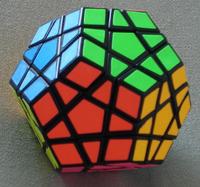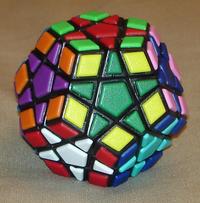| Revision as of 13:23, 13 January 2007 edit66.153.233.211 (talk) ←Replaced page with 'Welcome to the Megaminx http://i89.photobucket.com/albums/k213/Hormoans/Blawp.jpg If it were that cool, you'd probably own one.'← Previous edit | Revision as of 13:23, 13 January 2007 edit undoAntiVandalBot (talk | contribs)258,750 editsm BOT - rv 66.153.233.211 (talk) to last version by Sir Nicholas de Mimsy-PorpingtonNext edit → | ||
| Line 1: | Line 1: | ||
| ] | |||
| Welcome to the Megaminx | |||
| ] | |||
| The '''Megaminx''' is a ]-shaped puzzle similar to the ]. It has a total of 50 movable pieces to rearrange, compared to the 20 of the Rubik's cube. | |||
| == History == | |||
| http://i89.photobucket.com/albums/k213/Hormoans/Blawp.jpg | |||
| The Megaminx, or Magic Dodecahedron, was invented by several people simultaneously and produced by several different manufacturers with slightly different designs. ] eventually bought the rights to some of the patents and continues to sell it in his puzzle shop, , under the Megaminx moniker. | |||
| == Description == | |||
| The Megaminx is made in the shape of a ], and has 12 face center pieces, 20 corner pieces, and 30 edge pieces. The face centers each have a single color, which identifies the color of that face in the solved state. The edge pieces have two colors, and the corner pieces have three colors. Each face contains a center piece, 5 corner pieces and 5 edge pieces. The corner and edge pieces are shared with adjacent faces. The face centers can only rotate in place, but the other pieces can be permuted by twisting the face layer around the face center. | |||
| If it were that cool, you'd probably own one. | |||
| There are two main versions of the Megaminx: the 6-color version in which opposite faces have the same color, and the 12-color version in which all faces have a different color. | |||
| The purpose of the puzzle is to scramble the colors, and then restore it to its original state of having one color per face. | |||
| == Solutions == | |||
| In spite of its daunting appearance and greater number of possible positions, the Megaminx is not much more difficult than the standard 3x3x3 ]. This is because it is not a deep-cut puzzle; it only has pentagonal face layers which are similar in structure to the square face layers of the cube. There are no pieces that do not have a counterpart on the cube. Many of the techniques employed in the solution of the Rubik's cube can also be adapted for the Megaminx, except those that involve turning the center slice of the cube, since the Megaminx has no equivalent slice. | |||
| The 6-color Megaminx comes with an additional challenge which is not immediately obvious. Its edge pieces come in visually-identical pairs, because of the duplicated colors of opposite faces. However, although visually indistinguishable, they are nevertheless mathematically bound in a ] relationship. In any legal position (that can be reached from the solved state without disassembling the puzzle), there is always an even number of swapped pairs of edges. However, because swaps may be between visually indistinct edges, one may find that having solved almost the entire puzzle, one is left with a pair of swapped (distinct) edges that seems to defy all attempts to exchange them. The solution is to swap a single pair of 'identical' edges to reverse the parity, and then restore the rest of the puzzle. | |||
| This property is absent in the 12-color Megaminx, because all its edges are visually distinct, and it would be immediately obvious that there is another pair of swapped edges besides the pair one is working with. | |||
| == Number of Combinations == | |||
| The 12-color Megaminx has 1.0×10<sup>68</sup> possible combinations, and the 6-color Megaminx has 6.1×10<sup>63</sup>. | |||
| == See also == | |||
| *] | |||
| *] | |||
| *] | |||
| *] | |||
| *] | |||
| == External links == | |||
| *—contains solutions and other information | |||
| *—a Java applet that solves the Megaminx with animation | |||
| * | |||
| ] | |||
| ] | |||
| ] | |||
| ] | |||
Revision as of 13:23, 13 January 2007


The Megaminx is a dodecahedron-shaped puzzle similar to the Rubik's Cube. It has a total of 50 movable pieces to rearrange, compared to the 20 of the Rubik's cube.
History
The Megaminx, or Magic Dodecahedron, was invented by several people simultaneously and produced by several different manufacturers with slightly different designs. Uwe Meffert eventually bought the rights to some of the patents and continues to sell it in his puzzle shop, Meffert's, under the Megaminx moniker.
Description
The Megaminx is made in the shape of a dodecahedron, and has 12 face center pieces, 20 corner pieces, and 30 edge pieces. The face centers each have a single color, which identifies the color of that face in the solved state. The edge pieces have two colors, and the corner pieces have three colors. Each face contains a center piece, 5 corner pieces and 5 edge pieces. The corner and edge pieces are shared with adjacent faces. The face centers can only rotate in place, but the other pieces can be permuted by twisting the face layer around the face center.
There are two main versions of the Megaminx: the 6-color version in which opposite faces have the same color, and the 12-color version in which all faces have a different color.
The purpose of the puzzle is to scramble the colors, and then restore it to its original state of having one color per face.
Solutions
In spite of its daunting appearance and greater number of possible positions, the Megaminx is not much more difficult than the standard 3x3x3 Rubik's cube. This is because it is not a deep-cut puzzle; it only has pentagonal face layers which are similar in structure to the square face layers of the cube. There are no pieces that do not have a counterpart on the cube. Many of the techniques employed in the solution of the Rubik's cube can also be adapted for the Megaminx, except those that involve turning the center slice of the cube, since the Megaminx has no equivalent slice.
The 6-color Megaminx comes with an additional challenge which is not immediately obvious. Its edge pieces come in visually-identical pairs, because of the duplicated colors of opposite faces. However, although visually indistinguishable, they are nevertheless mathematically bound in a parity relationship. In any legal position (that can be reached from the solved state without disassembling the puzzle), there is always an even number of swapped pairs of edges. However, because swaps may be between visually indistinct edges, one may find that having solved almost the entire puzzle, one is left with a pair of swapped (distinct) edges that seems to defy all attempts to exchange them. The solution is to swap a single pair of 'identical' edges to reverse the parity, and then restore the rest of the puzzle.
This property is absent in the 12-color Megaminx, because all its edges are visually distinct, and it would be immediately obvious that there is another pair of swapped edges besides the pair one is working with.
Number of Combinations
The 12-color Megaminx has 1.0×10 possible combinations, and the 6-color Megaminx has 6.1×10.
See also
External links
- Jaap's Megaminx page—contains solutions and other information
- Megaminx Solver—a Java applet that solves the Megaminx with animation
- Another Java applet